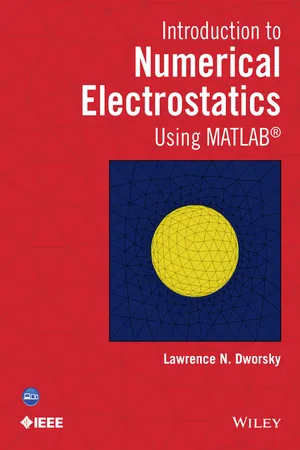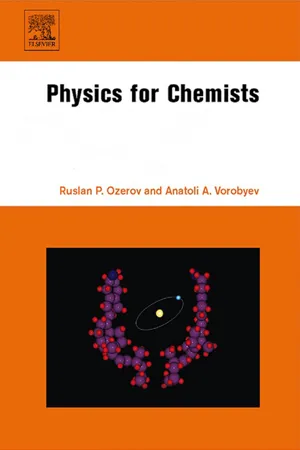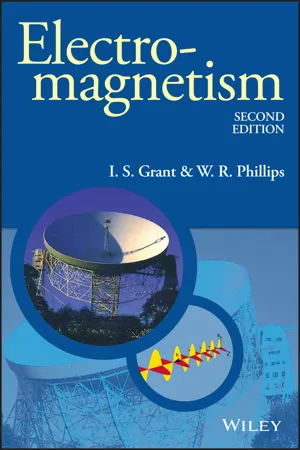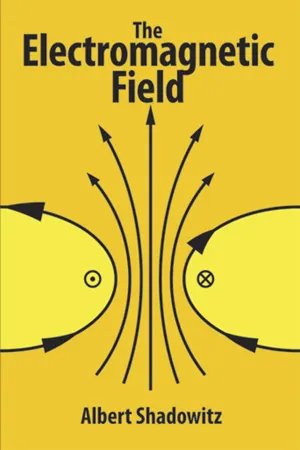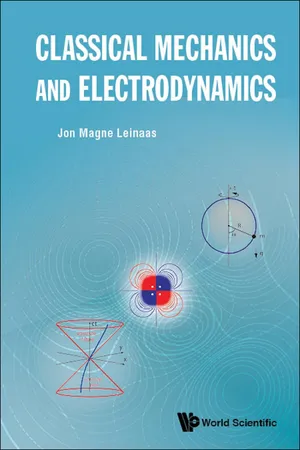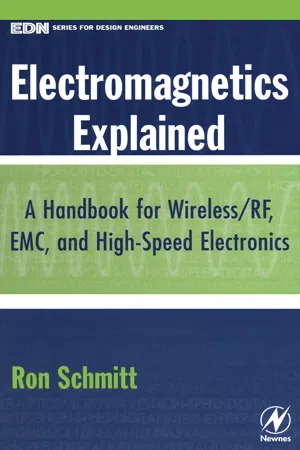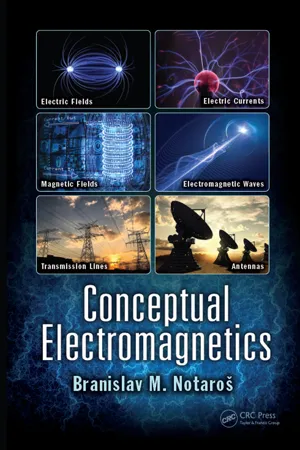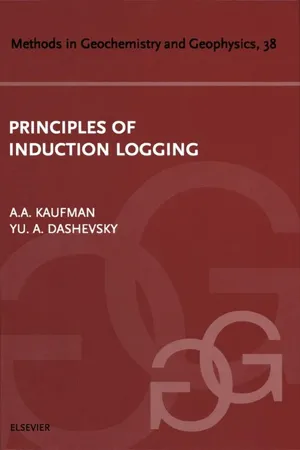Physics
Electric Field of a Dipole
The electric field of a dipole is the force experienced by a test charge placed in the vicinity of a dipole. It is a vector quantity that points from the negative to the positive charge of the dipole. The magnitude of the electric field of a dipole decreases with distance from the dipole according to an inverse cube law.
Written by Perlego with AI-assistance
Related key terms
Related key terms
1 of 4
Related key terms
1 of 3
12 Key excerpts on "Electric Field of a Dipole"
- eBook - ePub
- Michael Pycraft Hughes(Author)
- 2018(Publication Date)
- CRC Press(Publisher)
Figure 2.2 A point charge will generate an electric field, such as the one shown above. The electric fields lines travel from positive charges to negative charges (or to infinity if no negative charges are present, as here). The magnitude on the electric field is equivalent to the proximity of the field lines and is indicated here by the depth of tone in the halo surrounding the charge.To consider the effect of many charges interacting, we can employ the principle of superposition. This states that for a linear system, the total response to a set of stimuli is equal to the combined sum of the responses to each of the stimuli applied separately. In the context of our electric fields, it means that the electric field at any point in a system of multiple charges is equal to the vector addition of all the individual electric fields due to all the charges; for example, Figure 2.3 shows the electric field patterns due to two charges with like and unlike signs at close range.Another important concept is that of electrostatic potential, defined as the work done to move a unit charge between two points with different electric field values. If we consider the force on a unit charge in electric field E, from Equation 2.2 the force on the charge will be E, and the counterforce required to maintain it in position is –E. The work done to move this a small distance dl will be –Edl, and so the charge in electrostatic potential can be given byd V = - E . d l(2.3) If we integrate Equation 2.3 along the path between two points a and b, then we obtain an expression for the electrostatic potential:V =V b−V a−∫E . d l(2.4) The electrostatic potential (units: volts) is a scalar quantity and is familiar to those who have studied electronics. The relationship between the electric field and the electrostatic potential is perhaps best envisaged as the reverse of Equation 2.4 - Lawrence N. Dworsky(Author)
- 2014(Publication Date)
- Wiley-IEEE Press(Publisher)
L).If an electric dipole is placed in a uniform electric field, there will be no net translation (movement of the center of gravity of the system) force on the dipole. The force trying to move the dipole in the direction of the field will be exactly canceled by the force trying to move the dipole against the direction of the field.A dipole will rotate in a uniform electric field so as to align itself with the field. If we define the vector L as the line from charge -Q to charge +Q, then we can define the dipole moment as(1.78)and then the dipole torque in the uniform field is(1.79 )As equation (1.79 ) predicts, the torque is maximum when the dipole is normal to the field (along the X axis in Figure 1.16 ) and zero when the dipole is aligned with the field (along the X axis in Figure 1.17 ).Electric dipole in a uniform field.FIGURE 1.16Section of concentric circles demonstrating a nonuniform field.FIGURE 1.17Figure 1.17 depicts a situation with a nonuniform electric field. Concentric circular (cross sections of long cylinders) electrodes were chosen for this example because the field lines can be drawn exactly without getting embroiled in calculations.In this geometry all of the field lines are identical in that they are radial and all have the same magnitude–radius relationship. The nonuniform characteristic of these lines is that no two of them will point in the same direction; remember that two vectors have to agree in magnitude and direction for them to be identical. More complex geometries can be chosen in which the field lines differ in magnitude and direction, but this “extra” characteristic is not necessary for the point of this discussion.In the situation depicted in the figure, two effects take place concurrently. First, as in the previous example, the dipole will rotate so that the -Q- eBook - ePub
- Ruslan P. Ozerov, Anatoli A. Vorobyev(Authors)
- 2007(Publication Date)
- Elsevier Science(Publisher)
In order to describe a dipole field, we use the superposition principle: φ = φ + + φ –, i.e., φ = (| q | / 4 π ɛ 0 r +) - (| q | / 4 π ɛ 0 r -) = | q | (r - - r +) / 4 π ɛ 0 r + r -, We consider the point dipole (l r) (Figure 4.14); therefore, r – r + ≈ r 2, r – – r + ≈. l cos θ which means that φ (r, q) = | q | ℓ 4 π ɛ 0 r 2 cos θ = p 4 π ɛ 0 r 2 cos θ. (4.1.30) (4.1.30) In order to determine the strength of the dipole field at point A, the relationship between strength and potential can be used. We use a polar coordinate r and θ with a polar axis coinciding with the dipole arm direction (Figure 4.15). Component E r (projection E on the radius vector r) is Figure 4.15 Dipole electric field calculation. E r = d φ d r = 2 p 4 π ɛ 0 r 3 cos θ. The E θ component perpendicular to r is equal to E θ = d φ r d θ = p 4 π ɛ 0 r 3 sin θ, where r dθ is the length of an arc with radius r. Then, the total electric field strength at point A is E = E r 2 + E θ 2 = p 4 π ɛ 0 r 3 1 + 3 cos 2 θ. (4.1.31) (4.1.31) The potential and strength of the dipole field are defined not by a value of charge q but by the dipole electric moment p = | q | l. With distance, the dipole potential and strength decrease faster (φ ~ 1/ r 2, E ~ 1/ r 3) than those of a field of a point charge (1/ r and 1/ r 2, respectively). A configuration of the dipole electric field is shown schematically in Figure 4.16. Figure 4.16 A dipole electric field configuration. In a uniform electric field a torque M F aspires to turn the dipole moment p to be oriented along the field E. A force couple M F is equal to the product of force F = | q | E and the force arm l sin α (Figure 4.17), i.e., M = | q | El sin α = pE sin α or, in vector form, Figure 4.17 Electric dipole in a uniform electric field. M F = [ pE ]. (4.1.32) (4.1.32) The vector M is directed perpendicular to the plane of drawing from a spectator - eBook - ePub
- Michael M. Mansfield, Colm O'Sullivan(Authors)
- 2020(Publication Date)
- Wiley(Publisher)
The electric field strength at P can then be determined by dividing D by ε of the medium. Figure 16.17 Determination of an expression for the electric field strength at P due to an electric dipole. The unit vector i is taken along the dipole axis. We now derive an expressions for the electric flux density and field strength at a point at a distance r from the centre of a dipole of length 2 l for the special case in which. Using the cosine rule (Appendix A.3.3) we obtain and From the rule for vector addition we can write and from which we can determine expressions for and as follows. Substituting these results in Equation (16.9) we obtain Expanding each of the terms in brackets in the denominators in a binomial series (Appendix A.9.2) and neglecting terms of order etc. which are small compared to we get Finally, since, we get and hence (16.10) or (16.11) where the quantity p is the electric dipole moment of the dipole which is defined as where n is a unit vector directed along the axis of the dipole from negative to positive (for example, the i direction in Figure 16.17). Torque on an electric dipole in an electric field Consider an electric dipole in a uniform electric field of strength E, as shown in Figure 16.18. The dipole experiences the effect of equal and opposite forces of magnitude qE acting on each pole; that is, a torque (Section 7.3) of, where is the angle between the magnetic axis and the direction of the field. This can be written in vector form as (16.12) where p is the electric dipole moment as defined above. Figure 16.18 Torque on an electric dipole in a uniform electric field. Potential energy of an electric dipole in an electric field Finally in this section, we derive an expression for the potential energy of an electric dipole in an electric field which we assume is uniform over the dimensions of the dipole - eBook - ePub
- I. S. Grant, W. R. Phillips(Authors)
- 2013(Publication Date)
- Wiley(Publisher)
only about one hundred thousandth of the diameter of an atom. It is because of the smallness of the displacement that polarization effects are proportional to the magnitude of the electric field. The amount of polarization is determined by the balance between the external forces trying to displace electrons and the internal restoring forces. If electrons were moved away from their equilibrium position through distances comparable with the size of an atom, the restoring forces would certainly include higher powers of the displacement than the first. But the higher order terms are quite negligible for the small displacements caused by polarization, even in the highest electrostatic fields. The induced dipole moment of a molecule is always proportional to the magnitude of the electric field in which the molecule is situated.2.2.1 The local field
For a uniformly polarized dielectric, Equation (2.8) establishes a connection between the average dipole moment of a single molecule and the macroscopic electric field. However, the macroscopic field, which has been smoothed out over a region large enough to contain many molecules, is not necessarily the same as the local field polarizing one molecule. The local field Elocal acting on a particular molecule is the field generated by all charges outside the molecule: in other words Elocal is the same as the atomic field except that the field generated by the charges making up the molecule in question has been subtracted away.As well as the fields due to charges outside the dielectric and to polarization charges on its surface, the local field includes contributions from nearby neutral molecules. In section 1.5.3 the potential at a distance r from an electric dipole made up of two point charges was expanded as a series in (1/r ). The leading term depends on the dipole moment p, and is given in Equation (1.31) asExactly the same expression applies for a molecule with dipole moment p. Since this potential is proportional to (1/r )2 , the field associated with the dipole moment is proportional to (1/r )3 , and falls off rapidly with distance. The field outside a molecule also has terms in higher powers of (1/r - eBook - ePub
- (Author)
- 2012(Publication Date)
- Dover Publications(Publisher)
3. The force on a dipole A completely separate problem from that in Example 2 is this: find the force exerted on an electric dipole by an external electric field E .Figure 6-5 illustrates this case. Suppose we consider the i th component (i = 1.2,3) of the force F * on the positive charge +q of a dipole. Let the i th electric field component at the center of the dipole be E i ; then at the point l where the charge +q is located, this component, by a Taylor expansion, is E i + (∇E i ) (1/2). The higher-order terms have been neglected here by assuming that is small. So, F i + = (+q ) [E ¡ + (∇E i ) · (+1/2)], while similarly, the i th force component on the negative charge isThe total i th component force on the dipole, itself, will then beSoThis was derived for the case of a dipole, with small but finite 2; but the result is unchanged in the limit of a point dipole with the same dipole moment p. Consequently, this is called the dipole force; though, for a real dipole it is only true if the field does not vary too fast with distance. Otherwise one would require higher-order terms in the expansion. The meaning of the expression for F i can be seen more clearly by explicit expansion, say, of the x component.FIGURE 6-4If E x is a constant then F x is zero. Similarly for the other components. A translational force is exerted on an electric dipole only when the electric field is not constant, but varies from point to point.An alternative expression for the force on the dipole may be obtained from a vector identity.In ∇(A · B) = (A · ∇)B + (B · ∇)A + A × (∇ × B) + B X (∇ × A)let A = p and B = E .ThenF = ∇ (p · E ) (E · ∇)p - p × (∇ × E ) - E × (∇ × p)The dipole moment p is given here; it does not depend on x , y , or z . Consequently(E · ∇ )p = 0 and ∇ × p = 0so the electrical force on the dipole isF = ∇ (p · E ) - p × (∇ × E )But in electrostatics∇ × E = 0soF = ∇(p · E ) = - ∇(-p · E )FIGURE 6-5This result is only valid in electrostatics. When E varies with time it will be found subsequently that ∇ X E ≠ 0; then the expression for F also contains the term -p × (∇ × E). - eBook - ePub
- Jon Magne Leinaas(Author)
- 2018(Publication Date)
- WSPC(Publisher)
When considering the electric field far from the charges, it is often sufficient to consider only the first terms of the multipole expansion. In particular that is the case when we are interested in electromagnetic radiation far from the source, as we shall soon consider. In that case the field is determined by the time derivatives of the multipole moments. Since the total charge is conserved there will be no contribution from the monopole term, but for large r the main contribution will be from the electric dipole term, unless this term is absent. Elementary multipoles Elementary multipole fields can be produced by point charges in the following way. An elementary monopole field is simply the Coulomb field of a point charge located at the origin. This Coulomb field has no higher multipole components. A dipole field is produced by two point charges of opposite sign, ± q, located symmetrically about the origin, at positions ± d /2. The dipole moment of the charge configuration is p = q d. This field has no monopole component, and in the limit where d → 0 with qd fixed, all higher multipole components vanish and the electric field is a pure dipole field. Such an electric dipole field, with d finite, is illustrated in Fig. 11.2. In a similar way a pure quadrupole field can be produced by two dipoles of opposite signs, which have positions with a relative shift l. For this charge configuration only the quadrupole component of the electric field survives in the limit l → 0 with p l fixed. Such an elementary quadrupole field is shown in Fig. 11.3. Fig. 11.2 Electric dipole potential. Two electric point charges of opposite sign, but equal magnitude, are place at shifted positions. Equipotential lines are shown for a plane which includes the two charges. In the figure red corresponds to positive potential values and blue to negative values - eBook - ePub
Electromagnetics Explained
A Handbook for Wireless/ RF, EMC, and High-Speed Electronics
- Ron Schmitt(Author)
- 2002(Publication Date)
- Newnes(Publisher)
2 FUNDAMENTALS OF ELECTRIC FIELDSTHE ELECTRIC FORCE FIELD
To understand high-frequency and RF electronics, you must first have a good grasp of the fundamentals of electromagnetic fields. This chapter discusses the electric field and is the starting place for understanding electromagnetics. Electric fields are created by charges; that is, charges are the source of electric fields. Charges come in two types, positive (+) and negative (–). Like charges repel each other and opposites attract. In other words, charges produce a force that either pushes or pulls other charges away. Neutral objects are not affected. The force between two charges is proportional to the product of the two charges, and is called Coulomb’s law. Notice that the charges produce a force on each other without actually being in physical contact. It is a force that acts at a distance. To represent this “force at distance” that is created by charges, the concept of a force field is used. Figure 2.1 shows the electrical force fields that surround positive and negative charges.Figure 2.1 Field lines surrounding a negative and a positive charge. Dotted lines show lines of equal voltage.By convention, the electric field is always drawn from positive to negative. It follows that the force lines emanate from a positive charge and converge to a negative charge. Furthermore, the electric field is a normalized force, a force per charge. The normalization allows the field values to be specified independent of a second charge. In other words, the value of an electric field at any point in space specifies the force that would be felt if a unit of charge were to be placed there. (A unit charge has a value of 1 in the chosen system of units.)Electric field = Force field as “felt” by a unit chargeTo calculate the force felt by a charge with value, q, we just multiply the electric field by the charge,The magnitude of the electric field decreases as you move away from a charge, and increases as you get closer. To be specific, the magnitude of the electric field (and magnitude of the force) is proportional to the inverse of the distance squared. The electric field drops off rather quickly as the distance is increased. Mathematically this relation is expressed as - eBook - ePub
- Branislav M. Notaroš(Author)
- 2017(Publication Date)
- CRC Press(Publisher)
(2.1) , is termed the polarization of the dielectric, and bound charges are sometimes referred to as polarization charges. This process is extremely fast, practically instantaneous, and the dielectric in the new electrostatic state is said to be polarized or in the polarized state.Figure 2.1Small electric dipole representing an atom or molecule of a dielectric material in an external electric field.To describe and analyze the polarized state of a dielectric, we introduce a macroscopic quantity called the polarization vector, defined by averaging dipole moments in an elementary volume dv as follows:P =( polarization vector ; unit : C /( ∑ p ) in d vd vm 2) .(2.2) Once the distribution of the vector P inside a dielectric body is known, the macroscopic distribution of volume and surface bound (polarization) charge densities [see Eqs. (1.5 and (1.6) ], ρp and ρps , throughout the body volume and over its surface, respectively, which represent macroscopic equivalents of all microscopic electric dipoles and their charges, are obtained asρ p= − div P = − ∇ ⋅ P ,ρ ps=n ^⋅ P (n ^outward normal )( bound volume and surface charge densities ) ,(2.3) wheren ^stands for the normal unit vector on the surface oriented from the dielectric body outward. The electric field due to the polarized dielectric equals the field due to these volume and surface charges considered to be in a vacuum, as the rest of the material does not produce any field.CONCEPTUAL QUESTION 2.1Torque on an electric dipole in a uniform electrostatic field.An electric dipole, with charges Q and −Q, is placed in a uniform electrostatic field, whose intensity vector is E, as shown in Figure 2.2 . The field exerts a torque on the dipole for1 - eBook - ePub
- Avital Kaufman, Yu.A. Dashevsky(Authors)
- 2003(Publication Date)
- Elsevier Science(Publisher)
The electric field is located in planes perpendicular to the dipole axis and it has only the component E ϕ. In accord with eq. 2.6 : E ϕ = curl ϕ A * = 1 R (∂ ∂ R (R A θ *) − ∂ A R * ∂ θ) (2.17) It is obvious that: A R * = A z * cos θ A θ * = − A z * sin θ Substituting these expressions into eq. 2.17 after simple transformations we obtain: E ϕ = C 1 R 2 e i k R (1 − i k R) sin θ (2.18) In particular, for a nonconducting medium letting σ = 0 we have: E ϕ = C 1 R 2 sin θ since k = 0. It is obvious that this expression describes the primary vortex electrical field, caused by a change of the primary magnetic field with time, that is: E ϕ (0) = C 1 R 2 sin θ On the other hand, as follows from the previous chapter (section 1.4), we. have: E ϕ (0) = i ω μ M 4 π R 2 sin θ Comparing these last two expressions we define the unknown constant C : C = i ω μ M 4 π (2.19) The vector of the magnetic field has two components: H θ = σ A θ * − grad θ U * H R = σ A R * − grad R U * In accord with eq. 2.16 we. have: grad R U * = M 4 π e i k R (2 i k R 2 − 2 R 3 + k 2 R) cos θ grad θ U * = − M 4 π R 3 e i k R (1 − i k R) sin θ Therefore: H θ = M 4 π R 3 e i k R (− k 2 R 2 + 1 − i k R) sin θ[--=PLGO-SE. PARATOR=--]H R = 2 M 4 π R 3 e i k R (1 − i k R) cos θ Finally, we obtain the following expressions for complex amplitudes of the electromagnetic field of the magnetic. dipole: E ϕ = i ω μ M 4 π R 2 e i k R (1 − i k R) sin θ (2.20) H R = 2 M 4 π R 3 e i k R (1 − i k R) cos θ (2.21) H θ = M 4 π R 3 e i k R (1 − i k R − k 2 R 2) sin θ (2.22) Proceeding from these equations we will investigate the behavior of the electromotive force induced in the receiver of the. two coil induction probe as well as the main features of the distribution of induced currents. Suppose that a receiver coil is significantly smaller than the length of the induction probe. In other words, it will be assumed that all turns of the coil have the same area and they are located at some distance from the transmitter coil - eBook - ePub
Dielectrophoresis
Theory, Methodology and Biological Applications
- Ronald R. Pethig(Author)
- 2017(Publication Date)
- Wiley(Publisher)
This gradient is expressed mathematically as the vector ∇E (variously known as ‘grad’ E or ‘del’ E) where the symbol ∇ functions as a differential operator, such that: (3.11) Figure 3.8 Some of the field lines are drawn between a positive and negative charge. The direction of the electric field vector E at point (e.g., A or B) is given by the tangent to the field line at that point. The magnitude of the field will vary along a field line, and have components E x, E y, E z, along the x-, y- and z-directions. Although Faraday's lines of electric force cannot be interpreted as the lines of flow of a liquid, Maxwell was able to show that a hydrodynamic analogy can be made by defining an electric ‘displacement’ field D in a medium of specific inductive capacity (i.e., dielectric constant or relative permittivity) r as: (3.12) In equation (3.12) the relative permittivity r is a number – it is dimensionless. The factor D / 0 therefore has dimensions of an electric field (i.e., force per unit charge). Thus, in Maxwell's view, electric charges no longer appear as the centres of force envisaged by Faraday, but rather as sources of flux of force. The term ‘displacement’ was used to describe the imagined subtle movement (shift) of bound charges within each molecular element of a dielectric material in response to an imposed electric field. In modern terms we know that a dielectric consists of an electrically neutral atomic structure, where the total negative charge of all the electrons exactly balances out the positive charges of the nuclei about which they orbit. Although these charges cannot migrate through the dielectric to produce a conventional electric current, they can exhibit subtle displacements in an electric field. Electrons will attempt to minimize their potential energy by distorting their orbital paths against the electric field (i.e., towards the anode) and the positive nuclei will try to move along the field (towards the cathode) - Keith C Brown(Author)
- 2020(Publication Date)
- Royal Society of Chemistry(Publisher)
eqn (11.2) is in terms of a unit vector:where Q s represents the source charge.So far, our equations have presumed a collection of discrete point charges. For a continuous distribution of charge our summation sign simply becomes an integral:There are three general types of charge distributions, charge distributed along a line, charge distributed over an area and charge distributed through a volume. We then add the distribution expression into the integral. For example, for volume distribution we can write in differential terms:(11.3)where we use ρ (x, y, z ) to represent the (continuous) distribution of charge throughout the volume as a function of position. The integral becomes:(11.4)How do we picture the electric field? There are two ways. The first is to use essentially the same view as the force fields pictured in Chapter 4 using vectors to indicate the magnitude and direction of the field at any point in space. This is a rather clumsy way to show the field as it is difficult to show the field at many points in space; the vectors take up so much room in the picture. The second, more elegant way is to use field lines . These are lines whose tangent is in the direction of the field vector at that point in space. So, for a simple single positive charge the two pictures are shown in Figures 11.1a and 11.1b
Index pages curate the most relevant extracts from our library of academic textbooks. They’ve been created using an in-house natural language model (NLM), each adding context and meaning to key research topics.
Explore more topic indexes
Explore more topic indexes
1 of 6
Explore more topic indexes
1 of 4

